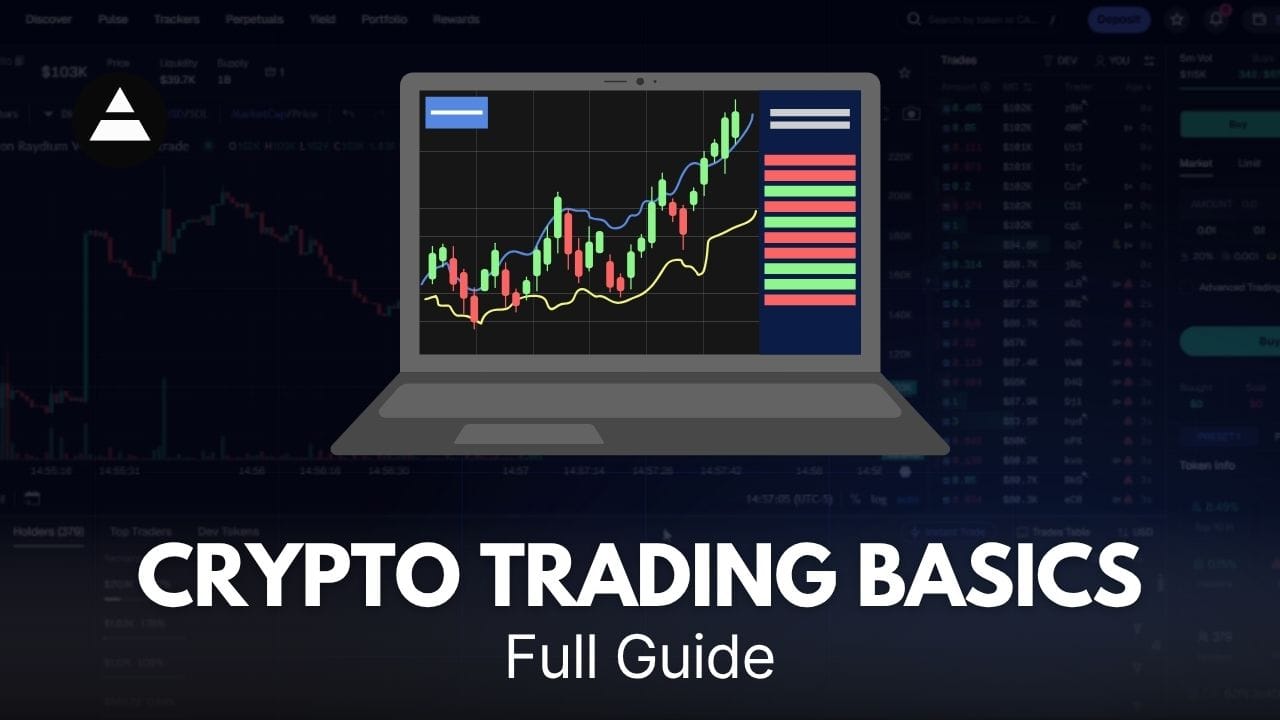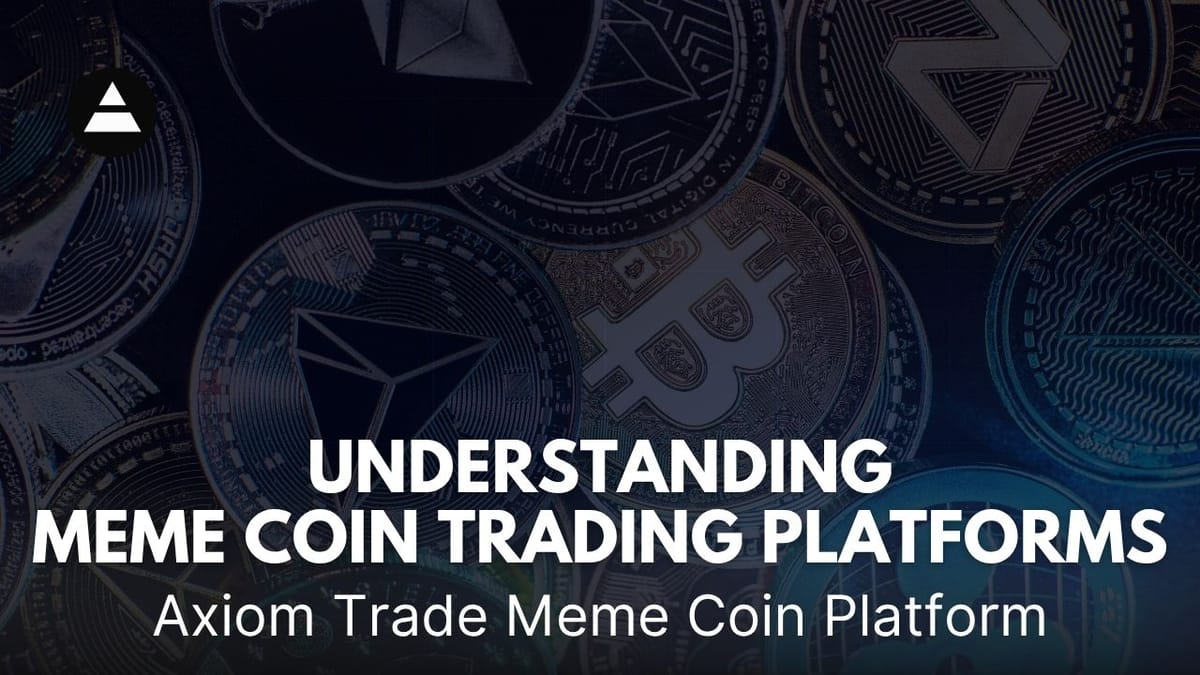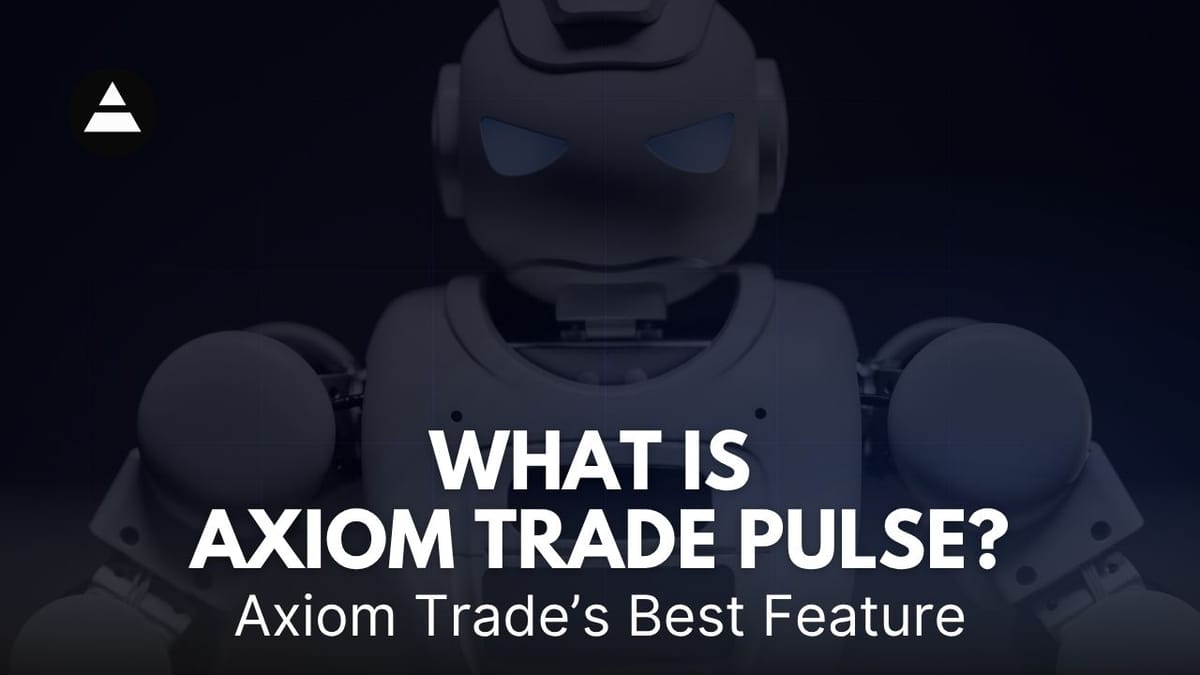Crypto Trading Basics: FULL GUIDE

What is Crypto Trading and How Does It Work?
Thinking about getting into crypto trading?
It might seem a bit much at first, but honestly, it's not as complicated as it looks.
We're going to break down the crypto trading basics so you can start trading with more confidence.
You'll learn about the different ways to buy and sell, how to keep your digital money safe, and even how to make some extra cash while you sleep.
Let's get you started.
Key Takeaways
- You can trade across different blockchains like Ethereum and Solana all in one place with platforms like Axiom Trading Bot.
- Simple buy and sell options are available, along with more advanced tools like limit orders for better price control.
- Understanding how to spot trading opportunities, like bundles, can give you an edge.
- Keeping your crypto safe is a big deal; look for non-custodial wallets and secure key management.
- You can earn passive income on your crypto, sometimes with good yearly rates and the ability to take your money out anytime.
Understanding Crypto Trading Basics
So, you're looking to get into crypto trading?
It's a wild world out there, but with a little know-how, you can start making sense of it all.
Think of crypto trading as buying and selling digital currencies like Bitcoin or Ethereum, hoping to make a profit from the price changes.
It's not too different from trading stocks, but the crypto market moves fast and can be pretty unpredictable.
The key is to understand the basics before you jump in.

What is Crypto Trading?
At its core, crypto trading is about speculating on the price movements of digital assets.
You're not necessarily buying crypto to use it for everyday purchases; you're buying it with the expectation that its value will increase, allowing you to sell it later for more than you paid.
This can happen over minutes, hours, days, or even longer.
It's a dynamic market, and understanding the fundamentals of what cryptocurrency is can help you get started. For instance, Bitcoin is the most famous example of a digital currency you can trade for profit.
Key Concepts in Crypto Trading
Before you start trading, you'll want to get familiar with some common terms and ideas.
You'll hear about things like:
- Volatility: This refers to how much the price of a crypto asset swings up and down. Crypto is known for being highly volatile.
- Liquidity: This is about how easily you can buy or sell an asset without affecting its price. High liquidity means you can trade quickly.
- Market Cap: This is the total value of a cryptocurrency, calculated by multiplying its current price by the total number of coins in circulation.
- Trading Pairs: Cryptocurrencies are often traded against other cryptocurrencies (like BTC/ETH) or against fiat currencies (like BTC/USD).
Understanding these concepts will give you a better grasp of how the market works.
It's also helpful to know about different types of trading, like spot trading versus futures trading.
Navigating the Crypto Market
Getting around the crypto market can feel a bit like learning a new language.
You'll encounter different types of cryptocurrencies, each with its own technology and purpose.
Some are focused on payments, others on smart contracts, and some are even built around internet jokes, like meme coins.
Platforms like Axiom Exchange are designed to make this easier, offering tools to help you trade various assets, including those popular meme coins.
You can even use tools to track wallets and monitor social media trends, which can sometimes signal market movements.
Getting a handle on these market dynamics is part of the learning curve.
The crypto market is always changing. What's popular today might not be tomorrow. Staying informed and adaptable is key to navigating these shifts successfully.
It's a good idea to start with a platform that offers clear information and tools to help you understand what's happening.
7 Years of Crypto Trading Knowledge in 50 Minutes
Essential Tools for Crypto Traders
To trade crypto effectively, you need the right gear.
Think of it like needing a good wrench set to fix a car; you can't just use pliers for everything.
In the crypto world, this means having a solid trading platform, a way to keep your digital money safe, and tools to understand what the market is doing.
Choosing a Trading Platform
When you're picking a place to trade, you want something that's easy to use but also has the features you need.
Some platforms are super simple, while others are packed with charts and data. Axiom Exchange is a good example of a platform that tries to balance both.
It's designed to be your go-to spot for trading on-chain, supporting things like Solana right now and planning to add more chains later.
They also have features like wallet tracking, which lets you see what successful traders are doing, and Twitter alerts so you don't miss out on important market news.
To get the most out of Axiom, like those Twitter alerts, you'll need to trade a certain amount of Solana. They also offer resources like guides and webinars to help you get better at trading.
You can check out their Discord community for more info.
Utilizing Wallet Integrations
Your crypto wallet is where your digital assets live.
When a trading platform can connect directly to your wallet, it makes things much smoother.
This means you don't have to move your crypto back and forth between different places, which can save time and reduce the risk of mistakes.
Axiom, for instance, acts as a hybrid trading app and wallet itself, built on top of decentralized protocols.
This means your funds stay under your control, which is a big deal for security.
Leveraging Advanced Analytics
Just buying and selling without looking at the data is like driving blindfolded.
You need tools that give you insights into market movements.
This could be charting tools that show price history, or more advanced analytics that look at on-chain data.
For example, Axiom has a feature called a 'Bundle Checker'. This tool helps identify when multiple buy transactions happen very close together within the same block, which can sometimes signal coordinated trading activity. They have specific rules to try and filter out noise and give you a more accurate picture of these bundles, which is different from how some other tools work.
Having access to these kinds of analytics can really help you make smarter trading decisions.
You can find more about different types of trading tools in this guide to crypto trading tools.
Keeping your digital assets secure and understanding market trends through analytics are two sides of the same coin when it comes to successful crypto trading. Both require careful attention and the right tools.
Executing Trades Effectively
Alright, let's talk about actually making trades.
You've got your platform set up, maybe you're using something like Axiom Trade which makes things pretty straightforward.
But knowing how to place those trades is key.
It’s not just about hitting a buy or sell button; there are different ways to do it, and understanding them can really help you get the prices you want.
Spot Buys and Quick Sells
This is the most basic way to trade.
A spot buy means you're buying an asset right now, at whatever the current market price is.
Think of it like walking into a store and buying something off the shelf.
A quick sell is the opposite – you're selling an asset immediately at the current market price.
It's simple and fast, good for when you just want in or out of a position without fuss.
This is your go-to for immediate market entry or exit.
Implementing Limit Orders
Limit orders are a bit more strategic.
Instead of buying or selling at the current market price, you set a specific price at which you're willing to trade.
For a limit buy, you set a price lower than the current market price.
Your order will only execute if the market price drops to your specified level.
For a limit sell, you set a price higher than the current market price, and it only sells if the market price rises to that point.
This gives you more control over your entry and exit points, helping you avoid paying more than you want or selling for less than you think your asset is worth.
It’s a smart way to trade when you have a specific target in mind, rather than just reacting to immediate price swings.
You can set these up on most platforms, including Axiom Trade.
How to Trade Crypto: Cryptocurrency Trading for Beginners
Understanding Migration Tools
Now, this is where things get interesting, especially with newer tokens or during specific market events.
Migration tools, like those you might find on Axiom, help you manage trades that involve moving assets or participating in specific token events.
Sometimes, a project might migrate its token to a new contract, or there might be opportunities to buy into a new token launch in a structured way.
These tools can help you execute these specific types of trades, often bundling multiple actions together.
For example, you might see options for 'Buy on Migration' or 'Sell on Migration'. These are designed to simplify complex transactions that might otherwise require multiple manual steps and could be prone to errors or missed opportunities if not handled quickly.
It’s about executing a series of actions as a single, efficient operation.
Trading involves risk, and using advanced tools like migration features requires a good grasp of what's happening with the specific token or project.
Always do your own research before committing funds, especially when dealing with new or migrating assets.
Here’s a quick look at how different order types compare:
Order Type | Action |
|---|---|
Spot Buy | Buys at the current market price |
Quick Sell | Sells at the current market price |
Limit Buy | Buys only if the price drops to your set level |
Limit Sell | Sells only if the price rises to your set level |
Migration Tools | Facilitates specific token event trades |
Advanced Trading Strategies
Ready to move beyond the basics?
This section dives into some more involved ways to trade crypto.
It's not just about buying low and selling high anymore; we're talking about strategies that require a bit more planning and understanding of market mechanics.
Bundle Detection for Trading
Ever heard of a 'bundle' in crypto trading?
Basically, it's when multiple buy transactions happen in the same block, often very close together in time.
Think of it like a group of people all trying to buy the same thing at the exact same moment.
Some platforms might just give you a general warning about this, but tools like Axiom are designed to be more specific.
They use rules, like flagging if four or more transactions occur in a single block, and also filter out wallets that only bundle once.
This helps you see which activities are more consistently bundled, giving you a clearer picture of potential market movements.
It's a way to spot orchestrated activity that might otherwise be hidden. You can check out how these tools work on platforms like Axiom Trade.
Identifying Trading Opportunities
Finding good trades isn't always obvious.
It involves looking at market trends, news, and sometimes even unusual on-chain activity.
For instance, noticing a sudden surge in transactions for a particular token, or seeing a pattern of bundled buys, could signal an opportunity.
It's about connecting the dots between different pieces of information.
Keeping an eye on social media, like Twitter, can also provide early signals.
Some traders use bots, like those offered by Axiom Trading Bot, to help scan for these patterns automatically, saving time and potentially catching opportunities you might miss.
High-Frequency Trading Insights
High-frequency trading, or HFT, is where trades happen incredibly fast, often in fractions of a second.
This is usually done by sophisticated algorithms and powerful computers.
For the average trader, directly competing in HFT is tough.
However, understanding its existence is important.
It can influence short-term price movements.
Platforms that offer fast execution speeds, like Axiom, can be beneficial if you're looking to make quicker trades, even if it's not full-blown HFT. It’s about having the tools to react swiftly to market changes.
You can find more on algorithmic trading in this guide to algorithmic crypto trading.
Being aware of these advanced concepts can help you make more informed decisions, even if you don't plan to implement them yourself. It's about understanding the different ways the market can move and how certain tools can help you participate.
Security and Asset Management
When you're trading crypto, keeping your assets safe is a big deal.
You don't want all your hard work to disappear because of a simple mistake or a security breach.
It’s about making sure your digital money stays yours.
Ensuring Non-Custodial Infrastructure
First off, you want to use platforms that don't hold your private keys.
This is called non-custodial.
It means you, and only you, have control over your funds.
Think of it like keeping your cash in your own pocket instead of a bank that could freeze your account.
Axiom Trade, for example, operates with a non-custodial setup, meaning your assets remain under your direct control. This is a pretty important point for anyone serious about crypto security.
Secure Key Management Practices
Your private keys are like the master key to your crypto vault.
You absolutely need to protect them.
This means:
- Not sharing them,
- Not storing them digitally
- Not writing them down on a sticky note
Using a hardware wallet is a good idea for long-term storage. For active trading, platforms like Axiom Trade offer secure ways to manage keys, often through encrypted storage or by integrating with secure wallet solutions.
Protecting Your Digital Assets
Beyond just keys, think about overall protection.
This includes being wary of phishing scams, using strong, unique passwords for all your accounts, and enabling two-factor authentication (2FA) wherever possible.
It's also smart to diversify your holdings across different assets and maybe even different platforms, though always stick to reputable ones.
Understanding the different types of crypto assets, like:
Can help you manage your portfolio better according to UK authorities' categorizations.
Staying informed about potential risks, like those associated with bundled transactions during token launches, is also key.
Tools like Axiom's bundle checker can help you spot these potential risks before you trade.
Here’s a quick checklist for asset protection:
- Use strong, unique passwords.
- Enable 2FA on all accounts.
- Never share your private keys or seed phrases.
- Be cautious of unsolicited offers or links.
- Consider a hardware wallet for significant holdings.
- Utilize security features offered by trading platforms like Axiom Trade.
Earning Passive Income with Crypto
So, you've been trading crypto, maybe making some good moves, but what if you could make your crypto work for you even when you're not actively trading?
That's where passive income comes in.
It's about setting up your assets to generate returns over time, kind of like earning interest, but with crypto.
There are a few ways to go about this, and it's worth looking into if you want your portfolio to grow without constant attention.
Strategies for Passive Income
There are several paths to earning passive income in the crypto space.
One common method is staking, where you lock up your coins to support a blockchain network and get rewarded for it.
Another is lending your crypto to others through platforms, earning interest on the loans.
Yield farming is also popular, though it can be more complex and involves providing liquidity to decentralized exchanges.
For those looking for a straightforward approach, platforms like Axiom Trade are making it easier to earn yield.
They often partner with lending protocols to offer competitive rates.
You can explore different strategies to see what fits your risk tolerance and goals best.
Understanding APY in Crypto
When you see terms like APY, it stands for Annual Percentage Yield.
This is basically the rate of return you can expect to earn on your crypto over a year, taking into account the effect of compounding interest.
So, if you see an APY of, say, 10%, it means your initial investment could grow by 10% in a year, assuming the rate stays the same.
Different platforms and strategies will offer different APYs, and it's important to understand that higher APYs often come with higher risks.
Always check the details of how the APY is calculated and what risks are involved before committing your assets.
You can find more information on generating yield in crypto here.
Instant Withdrawal Benefits
One of the big advantages when looking at passive income opportunities is the ability to withdraw your earnings and principal quickly.
Some platforms might lock your funds for a period, but others, like Axiom Trade, focus on providing instant withdrawals.
This means if you need access to your funds, you can get them without a long waiting period.
This flexibility is pretty important, especially in the fast-moving crypto market.
It gives you control and allows you to react to market changes or personal needs without being tied down.
Being able to get your money out when you want is a big plus for many users, offering peace of mind alongside potential earnings. You can also buy crypto through Axiom without needing to verify your identity here.
Want to make money with crypto without constantly watching the market?
Earning passive income in the crypto world is totally possible.
Explain Crypto To COMPLETE Beginners
Conclusion
So, you've learned the basics of crypto trading.
It's a lot to take in, right?
You've got your wallets, your exchanges, and now you're thinking about platforms like Axiom Trading Bot.
Think of it as a place where you can buy and sell quickly, keep an eye on your crypto, and even see what's happening on Twitter, all without leaving the app.
They even have features to help you spot tricky trading patterns, which can be a real headache otherwise.
Remember, trading involves risk, but having the right tools can make a big difference.
Keep learning, stay safe, and happy trading!
Frequently Asked Questions
What exactly is crypto trading?
Think of crypto trading like buying and selling digital coins like Bitcoin or Ethereum. You try to buy them when the price is low and sell them when the price goes up to make money. It's all done online using special apps or websites.
What stuff do I need to start trading crypto?
You'll need a place to trade, like a special app or website that lets you buy and sell crypto. You'll also want a digital wallet to keep your coins safe. Sometimes, you might use tools that help you watch the market and make smart decisions.
How do I actually buy and sell crypto?
There are different ways to trade! You can buy and sell right away at the current price, or you can set a specific price you want to buy or sell at, and the trade happens automatically when the market hits that price. It's like setting an alarm for your trade.
What's this 'bundle' thing people talk about?
Imagine you want to buy a bunch of different coins at once. Some tools let you do this easily, like grabbing a "bundle" of items. This can be a quick way to get into different parts of the crypto world.
How can I keep my crypto safe?
Keeping your digital money safe is super important! You want to use platforms that don't hold your private keys (that's called non-custodial), and manage your passwords and secret phrases very carefully. Think of it like protecting your secret diary.
Can I make money with crypto without trading all the time?
You can earn extra crypto without actively trading! Some platforms let you put your crypto to work, like lending it out, and you get paid interest. It's like putting money in a savings account, but with digital coins.
More Axiom Trade Guides:










